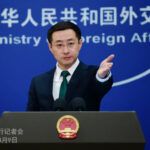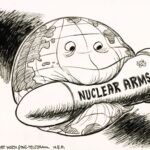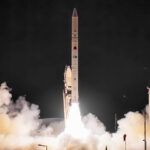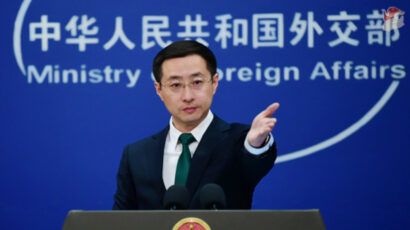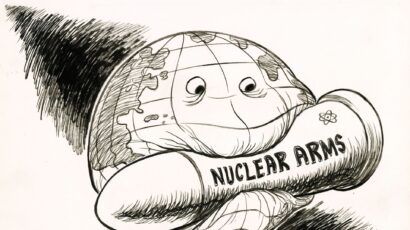Five steps to prevent another Fukushima
By Jungmin Kang | May 4, 2011
The situation at the Fukushima Daiichi nuclear plant has been an ongoing disaster since the March 11 earthquake and tsunami. According to an estimate by the Federation of Electric Power Companies of Japan, by April 27 approximately 55 percent of the fuel in reactor unit 1 had melted, along with 35 percent of the fuel in unit 2, and 30 percent of the fuel in unit 3; and overheated spent fuels in the storage pools of units 3 and 4 probably were also damaged. The accident has already surpassed the 1979 Three Mile Island accident in seriousness, and is comparable to the 1986 Chernobyl accident.
To prevent this kind of nuclear disaster from happening again, both the nuclear industry and government officials worldwide must seriously consider making at least five major changes to the safety systems at nuclear power plants, as well as to security measures and international agreements.
Stabilize the electricity supply system. The Fukushima nuclear accident is said to have been caused by an unprecedented natural disaster: a tremendous earthquake followed by a tsunami. What really caused the accident, however, was that the power plant simply ran out of electricity. Offsite power was cut off by the earthquake and tsunami; onsite emergency diesel generators malfunctioned; and batteries were empty within hours. With no electricity, there was no way to operate the emergency core-cooling systems for the reactors. The water inside the reactors boiled away, exposing the fuel, which then overheated and reacted with steam to produce combustible hydrogen gas. Hydrogen explosions tore through the reactor containment buildings and released radioactive gases — including cesium 137, the principal radioactive isotope released by the Chernobyl accident — from the damaged fuel. To prevent such a power loss in the future, plant operators should install multiple connections to the offsite power grid; station emergency diesel generators on high ground; and deploy plenty of mobile emergency diesel generators.
Store spent fuel in dry casks. The Fukushima accident was a vivid reminder that fuel storage pools are vulnerable when cooling systems fail. Like the fuel inside the reactor cores, some of the fuel stored in pools at Fukushima probably melted as water levels dropped, releasing radioactive gases into the atmosphere. To minimize the risks of a similar situation happening again, plant operators should remove spent fuel from pools after five years. By that time, the fuel is cool enough to be stored in dry casks, which are sealed metal cylinders surrounded by concrete or other materials. These casks provide robust protection against physical damage, and are expected to maintain their integrity for 100 years or more. More than 400 fuel assemblies — about three percent of the total amount of spent fuel — are already stored in dry casks at Fukushima Daiichi, and they apparently survived the earthquake and tsunami without any significant damage. Dry-cask storage also helps to alleviate shortages of storage-pool capacity, which some countries are facing.
Install filtered vent systems. In an accident like the one at Fukushima, a filtered vent system could reduce the possibility of containment-building explosions, by releasing radioactive gases to the atmosphere through a large filter system. This system traps the most dangerous radioactive species, including cesium 137, and prevents them from spreading beyond the containment building. A group of nuclear engineers at the University of California originally suggested this idea in 1977, and Frank von Hippel and Jan Beyea reintroduced the idea in the Bulletin of the Atomic Scientists in 1982. Some countries — including France, Sweden, and Germany — have installed filtered vent system at their reactors. But Japan, the United States, and many other countries with nuclear power plants have not adopted them.
Prevent sabotage at nuclear facilities. Even without a natural disaster such as an earthquake followed by a tsunami, a Fukushima-like nuclear accident can occur at any nuclear power plant that relies on water for cooling. A terrorist attack on a plant’s emergency core cooling system, for example, could have catastrophic results. The Fukushima accident implicitly shows the overlap between nuclear safety and nuclear security concerns, and these concerns should be addressed at the 2012 Seoul Nuclear Security Summit. After the terrorist attack of September 11, 2001, the Nuclear Regulatory Commission (NRC) reviewed security standards for nuclear power plants, and approved new regulations in December 2008. These regulations include specific guidelines about what should be done to: ensure that necessary security measures do not compromise plant safety; prevent theft or diversion of plutonium-bearing mixed-oxide (MOX) fuel; prevent cyber attacks; respond to an aircraft attack; mitigate the effects of large explosions and fires; implement more rigorous programs for authorizing personnel access; strengthen security personnel training and qualification; and enhance physical security. Regulations like those developed by the NRC should be implemented at nuclear power plants worldwide.
Ratify a treaty to prohibit military attacks. At Fukushima, water continues to leak from spent-fuel pools that were damaged by hydrogen explosions in mid-March. This poses a threat of radioactive gas releases from damaged fuel in the pools. A military attack on a nuclear facility could also cause this kind of damage — and radioactive releases. The consequences could be grave and could spread beyond national boundaries. Therefore, it is urgent that global communities ratify a treaty prohibiting the use of military forces against civilian nuclear facilities in IAEA member states. India and Pakistan already have a bilateral agreement not to attack each other’s nuclear facilities, entered into force in 1991. The agreement defines nuclear facilities as “nuclear power and research reactors, fuel fabrication, uranium enrichment, isotopes separation and reprocessing facilities as well as any other installations with fresh or irradiated nuclear fuel and materials in any form and establishments storing significant quantities of radioactive materials.” A multilateral non-attack treaty should be on the agenda for the Seoul Nuclear Security Summit.
Making these five changes will take time, so the work should begin as soon as possible. Cost is the primary impediment to installing alternative power sources, fuel-storage casks, and filtered vent systems — but these safety improvements are far less expensive than a major accident would be. As for new regulations and treaties, the challenge is finding the political willpower to make these changes. Here, too, the price of inaction could be unimaginably steep.
Together, we make the world safer.
The Bulletin elevates expert voices above the noise. But as an independent nonprofit organization, our operations depend on the support of readers like you. Help us continue to deliver quality journalism that holds leaders accountable. Your support of our work at any level is important. In return, we promise our coverage will be understandable, influential, vigilant, solution-oriented, and fair-minded. Together we can make a difference.
Topics: Nuclear Energy, Nuclear Weapons, Opinion




